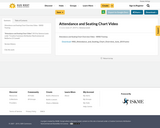
Attendance and Seating Chart Overview Video - SWSD Training
- Subject:
- Education
- Educational Technology
- Material Type:
- Primary Source
- Date Added:
- 06/27/2019

Attendance and Seating Chart Overview Video - SWSD Training
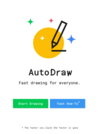
AutoDraw is a free, web-based drawing tool created by Google that utilizes artificial intelligence to help users quickly and easily create professional-looking drawings and illustrations. Its simplicity makes it accessible to anyone, regardless of age, who wants to explore AI.
As you begin sketching on the canvas, AutoDraw's AI recognizes your intentions and suggests relevant clip art images or icons. You can choose one of the suggested images to replace your rough sketch with a polished version. The AI learns from your selections and rejections, continually improving its suggestions.
AutoDraw is free.

Bamboo Learning is the leader in voice powered education, having won three national awards for voice-based e-learning tools. Our Alexa skills, Bamboo® Books, Bamboo® Luminaries, Bamboo® Math, Bamboo® Music, and Highlights Storybooks from Bamboo, get more challenging as students master different levels. Bamboo skills also track progress & award badges. Bamboo Grove is a web-based parent dashboard for parents to follow their children’s progress in Bamboo Learning’s Alexa skills.
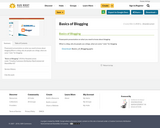
Powerpoint presentation on what you need to know about blogging
What is a blog, why do people use a blogs, what are some "rules" for blogging
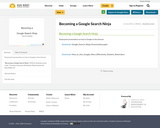
Powerpoint presentation on how to Google on the internet
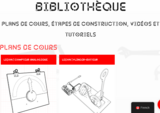
Plans de cours, Étapes de construction, Vidéos et Tutoriels
"Make Stuff Move souhaite que les élèves utilisent des outils et des matériaux de tous les jours pour apprendre et développer des compétences pratiques en construction, tout en faisant preuve de créativité pour résoudre des problèmes. Les disciplines STEM/STEAM sont excellentes, mais elles le sont encore plus lorsque des outils sont impliqués !
Cette bibliothèque d'apprentissage comprend :
*Des plans de cours
*Des instructions pas à pas
*Du codage
*Et bien plus encore !
(Des kits sont également disponibles à l'achat sur le site)"
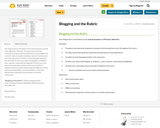
Your blog project is intended to serve several purposes and fill many objectives:
Purposes:
To express your personal responses to projects and learning that occurs throughout the course
To make connections between classroom learning and your own experiences
To reflect on learning opportunities in the classroom
To share your ideas and thoughts an audience – peers, parents, community (local/global)
To share your voice about issues and topics related to this course
To link to websites and sources with related materials
Objectives:
Share and present ideas
Make connections
Reflect on learning
Demonstrate respectful communication in an online environment
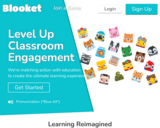
Welcome to the World of Blooket: a new take on trivia and review games! Sign up to get started! Introduction video @ https://www.youtube.com/watch?v=tFe9Rch0Q8w
The way it works is that a teacher/host picks a question set and a unique game mode. Then, we generate a code that players can use to join the game on their own devices. After the game starts, players will answer questions to help them win. That’s where the fun starts, because we offer a variety of games to keep students engaged and excited!
Students are encouraged to participate in games with rewards for answering questions and exploring new methods of learning. Overcoming our challenges drives students to perform well while reviewing.
Question sets can be painlessly imported or created easily with our powerful Set Builder. You can also explore our incredible collection of sets built by other amazing users on the Discover page.
Ditch the old, redundant classroom review game and try out our variety of unique, engaging game modes. Also, edit game settings with a variety of options to truly make Blooket the perfect tool for you.

Verbs for ideas for projects or activities for each level of Bloom's Taxonomy,

Aperçu : Bienvenue dans une autre leçon de codage Make Stuff Move. Cette deuxième leçon va vous montrer comment déplacer un servo à l'aide du bouton sur votre bouclier d'animation.
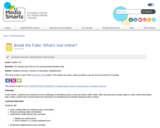
With a little help from the house hippo, in this lesson students are introduced to the challenges of identifying what is real and what is fake online.
Break the Fake lesson plans are available for grades K-12
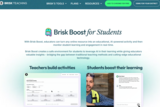
This innovative tool enables you to choose any online resource—such as PDF articles/text, videos, documents, or PPTs.
You can decide how it will engage with your students, whether acting as a tutor, facilitating debates, or assessing comprehension.
Just share a link with your students, and it will interact with them in the chosen manner.
As a teacher, you can also keep an eye on student progress while they work. All for free.
This is a Chrome extension.

Brisk Teaching is a free Chrome extension that leverages AI to help teachers save time and enhance their teaching methods. It integrates with Google Classroom, Docs, Slides, YouTube, Canvas, and Schoology, allowing educators to create instructional materials, provide feedback, evaluate student writing, adjust reading levels, generate personalized curriculum, and analyze class progress.
It's free but you can pay to get more features.

The Building Literacy with Technology in Elementary guide provides articles, samples, and lessons to find new ideas and approaches to engage learners in building skills in reading, writing, listening, and speaking.
In the Building Literacy with Technology in Elementary guide you will explore:
- Ways to get students making in language arts,
- Take a creative approach to student work with informational text,
- How to motivate students by creating their own comics, cartoons, and graphic novels.
The guide includes lesson plans where students:
- Design a new cover for a book they are reading to demonstrate comprehension and explore character, plot, setting, symbolism, and conflict.
- Create a digital scrapbook that showcases the viewpoint of the main character of a novel.
- Illustrate and translate the meaning of an idiom to help others learn these examples of figurative language.
- Write and produce an animated tall tale about a famous person.
- Explore character, plot, and theme and learn to write persuasively as they develop a movie-style trailer for a book they have read.
- Learn and practice persuasive writing and presentation skills.
- Personify an object and write a story as part of an online book or animated adventure.
- Analyze verse and explore meaning by creating a visual poem.
These articles, lessons, and strategies engage students through creative technology to maximize student literacy skills.

The Building Literacy with Technology in Primary guide provides articles, samples, and lessons to find new ideas and approaches to engage your students in building skills in reading, writing, listening, and speaking.
In the Building Literacy with Technology in Primary guide you will explore:
- Engaging new readers and writers with creative technologies
- Using digital storytelling in the primary classroom
- Inspiring every student to be an author
The guide includes lesson plans where students:
- Explore initial sounds through the creation of a classroom ABC book.
- Learn to write using alliteration and create illustrations that support and reflect their writing.
- Practice writing and illustrating as they create a page in your class’s adaptation of their favorite pattern story.
- Write a letter to their parents, or classroom teacher, to persuade them to get a new pet, supporting their opinion with reasons and examples.
- Research an animal and create a riddle to showcase their knowledge and engage other students in the natural world.
- Create a book review on a card or 3D cube to help others choose books they will enjoy.
- Learn about the haiku poetry form and write and illustrate their own haiku poems.
- Write how-to stories about getting ready for school and publish them to share with their families and to use at home.
These articles, lessons, and strategies engage students through creative technology to maximize student literacy skills.

"Thunkable enables anyone to build their own beautiful mobile apps. Using drag and drop code, students can start from scratch or remix a sample app. Created app projects are accessible on both iOS and Android platforms. Thunkable has an active community with regular design challenges to keep students thinking outside the box with their app creations." (AASL)
"With the free version of Thunkable, all app projects are set to public mode. This means that all projects are automatically included in the Thunkable Public Gallery, for anyone to preview and remix. With a PRO membership, you have the ability to create and edit private projects. This means that no one else will have access to your apps." There are paid versions available as well.
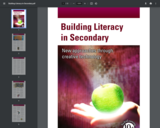
A combination of focused activities and creative, open-ended technology projects can help you take a new approach to building literacy with your secondary students. Use these articles, samples, and lessons to find new ideas and approaches that will work for your learners.
The Building Literacy in Secondary guide includes:
- Articles
- Reading, Literacy, and Digital Creativity
- SPLAT...POW...WOW! Motivating Readers and Writers
- More Than Just a Writing Prompt
- Supporting 6+1 Trait Writing
Lesson Plans
- Create a Video Poem
- Design a Book Cover
- Character Scrapbook
- Not Your Average Portfolio
- MyBook (Fakebook) Page
- Digital Book Trailers
These articles, lessons, and strategies engage students through creative technology to maximize student literacy skills.

In this lesson, students go further into the collection and interpretation of data, including cleaning and visualizing data. Students first look at the how presenting data in different ways can help people to understand it better, and they then create visualizations of their own data. Using a the results of a preferred pizza topping survey, students must decide what to do with data that does not easily fit into the visualization scheme that they have chosen. Finally, students look at which parts of this process can be automated by a computer and which need a human to make decisions.

In this lesson students get practice making decisions with data based on some problems designed to be familiar to middle school students. Students work in groups discussing how they would use the data presented to make a decision before the class discusses their final choices. Not all questions have right answers and in some cases students can and should decide that they should collect more data. The lesson concludes with a discussion of how different people could draw different conclusions from the same data, or how collecting different data might have affected the decisions they made.

Students begin the lesson by looking at a cake preference survey that allows respondents to specify both a cake and an icing flavor. They discuss how knowing the relationship between cake and icing preference helps them better decide which combination to recommend. They are then introduced to cross tabulation, which allows them to graph relationships to different preferences. They use this technique to find relationships in a preference survey, then brainstorm the different types of problems that this process could help solve.